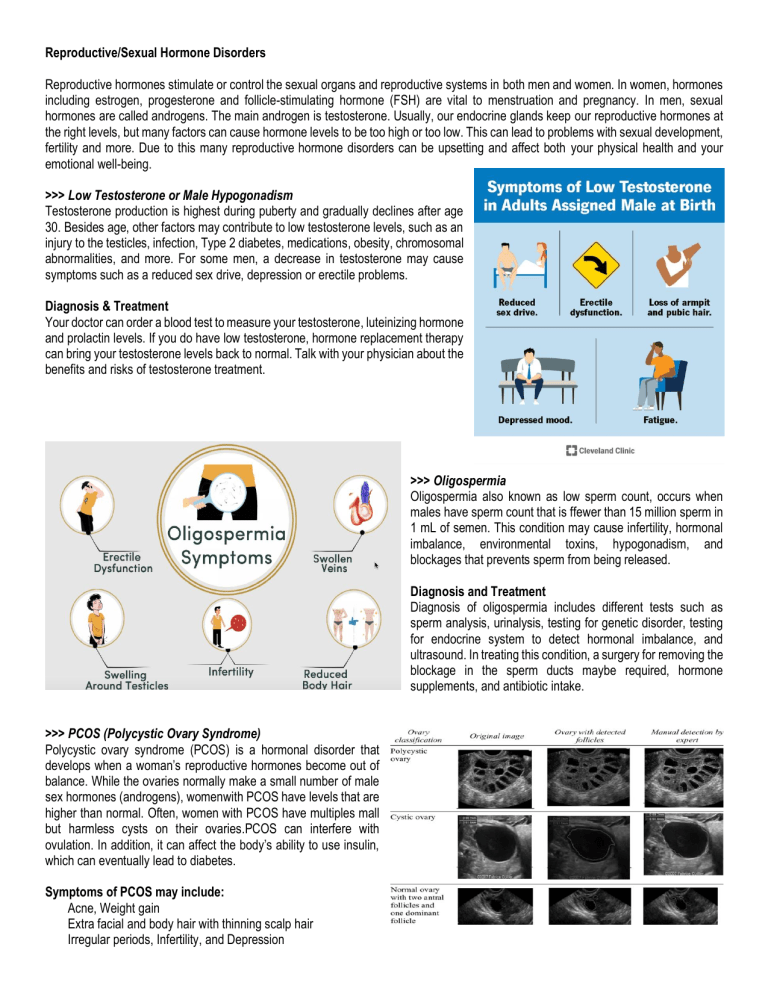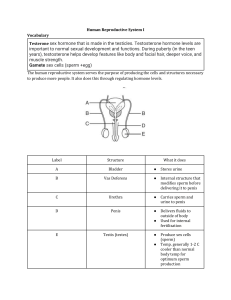
Reproductive/Sexual Hormone Disorders Reproductive hormones stimulate or control the sexual organs and reproductive systems in both men and women. In women, hormones including estrogen, progesterone and follicle-stimulating hormone (FSH) are vital to menstruation and pregnancy. In men, sexual hormones are called androgens. The main androgen is testosterone. Usually, our endocrine glands keep our reproductive hormones at the right levels, but many factors can cause hormone levels to be too high or too low. This can lead to problems with sexual development, fertility and more. Due to this many reproductive hormone disorders can be upsetting and affect both your physical health and your emotional well-being. >>> Low Testosterone or Male Hypogonadism Testosterone production is highest during puberty and gradually declines after age 30. Besides age, other factors may contribute to low testosterone levels, such as an injury to the testicles, infection, Type 2 diabetes, medications, obesity, chromosomal abnormalities, and more. For some men, a decrease in testosterone may cause symptoms such as a reduced sex drive, depression or erectile problems. Diagnosis & Treatment Your doctor can order a blood test to measure your testosterone, luteinizing hormone and prolactin levels. If you do have low testosterone, hormone replacement therapy can bring your testosterone levels back to normal. Talk with your physician about the benefits and risks of testosterone treatment. >>> Oligospermia Oligospermia also known as low sperm count, occurs when males have sperm count that is ffewer than 15 million sperm in 1 mL of semen. This condition may cause infertility, hormonal imbalance, environmental toxins, hypogonadism, and blockages that prevents sperm from being released. Diagnosis and Treatment Diagnosis of oligospermia includes different tests such as sperm analysis, urinalysis, testing for genetic disorder, testing for endocrine system to detect hormonal imbalance, and ultrasound. In treating this condition, a surgery for removing the blockage in the sperm ducts maybe required, hormone supplements, and antibiotic intake. >>> PCOS (Polycystic Ovary Syndrome) Polycystic ovary syndrome (PCOS) is a hormonal disorder that develops when a woman’s reproductive hormones become out of balance. While the ovaries normally make a small number of male sex hormones (androgens), womenwith PCOS have levels that are higher than normal. Often, women with PCOS have multiples mall but harmless cysts on their ovaries.PCOS can interfere with ovulation. In addition, it can affect the body’s ability to use insulin, which can eventually lead to diabetes. Symptoms of PCOS may include: Acne, Weight gain Extra facial and body hair with thinning scalp hair Irregular periods, Infertility, and Depression Diagnosis and Treatment For many women with PCOS, lifestyle changes are an important part of treatment. Losing weight can help bring the hormones back into balance. Getting regular exercise and eating a healthy diet also can help with symptoms. If needed, your doctor may recommend birth control pills or other medications to treat the hormone imbalance and relieve symptoms while you get back to good health. >>> Amenorrhea This condition causes the absence of menstruation in females at the age of 15 (primary amenorrhea) and three or more periods in a row (secondary amenorrhea). Signs and symptoms include milky nipple discharge, headache, hair loss, acne, and pelvic pain. Some causes of this condition are genetic problems, hormonal issues from the pituitary gland, obesity and underdeveloped reproductive system. Diagnosis and Treatment Diagnosis may include blood tests, ultarasound, genetic testing, and MRI. While treating this condition may require doing a diet and exercise plan recommended by a medical professional, management of stress, hormonal treatment, and surgery (for severe cases). Mechanism of Amenorrhea concerning problems with hormones References: Amenorrhea: Missing your period. Cleveland Clinic. (n.d.-a). https://my.clevelandclinic.org/health/diseases/3924-amenorrhea Oligospermia (low sperm count): Causes & treatment. Cleveland Clinic. (n.d.-c). https://my.clevelandclinic.org/health/diseases/22477-oligospermia-low-sperm-count. Date Retrieved: February 15, 2024. Low testosterone (low T): Causes, symptoms & treatment. Cleveland Clinic. (n.d.-b). https://my.clevelandclinic.org/health/diseases/15603-low-testosterone-male-hypogonadism. Date retrieved: February 15, 2024. Reddy, S. G., Veronikis, I., Rukhman, N., Senkottaiyan, N., & McGregor, V. (2021). Reproductive/sexual hormone disorders. Mercy. https://www.mercy.net/service/reproductivesexual-hormone-disorders/. Date Received: February 15, 2024. ******************************** Read and analyze the scenario below and answer the following guide questions. Anna and her husband have been trying to get pregnant for years but there was no luck. One time, she started to gain weight and thought that she has become pregnant because her period also got delayed for five straight months. However, the pregnancy test that she took came back negative. Because of this, her frustration on not having a child made her feel sand and lonely most of the time. Guide Questions: 1-2. Based on the situation above, what is the disorder that Anna is suffering from? 3-4. Elaborate the hormones that could have been affected by the disorder that Anna has. 5-6. List the possible things that Anna should do to help her ease the effects of the disorder she has: Anna’s husband, Jerry, is also frustrated for not being able to have child after years of marriage. Due to this, he also experiences different spikes in emotions such as sadness and he gets easily irritated. In addition, he got up to the point that the thought of making a child no longer interests him. 7-8. Based on the situation above, what is the disorder that Jerry is suffering from? 9-10. List the possible things that Jerry should do to help her ease the effects of the disorder he has:

